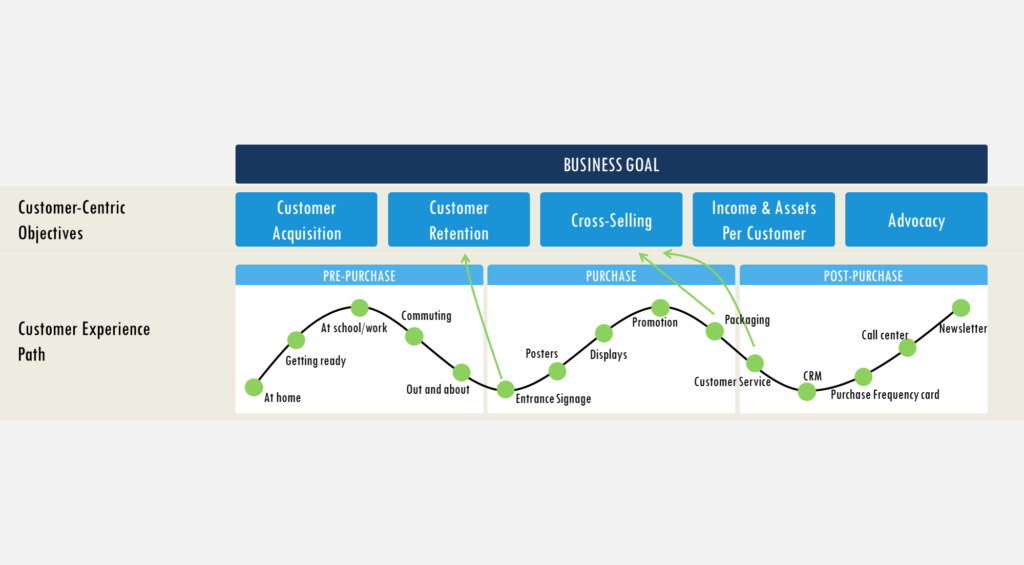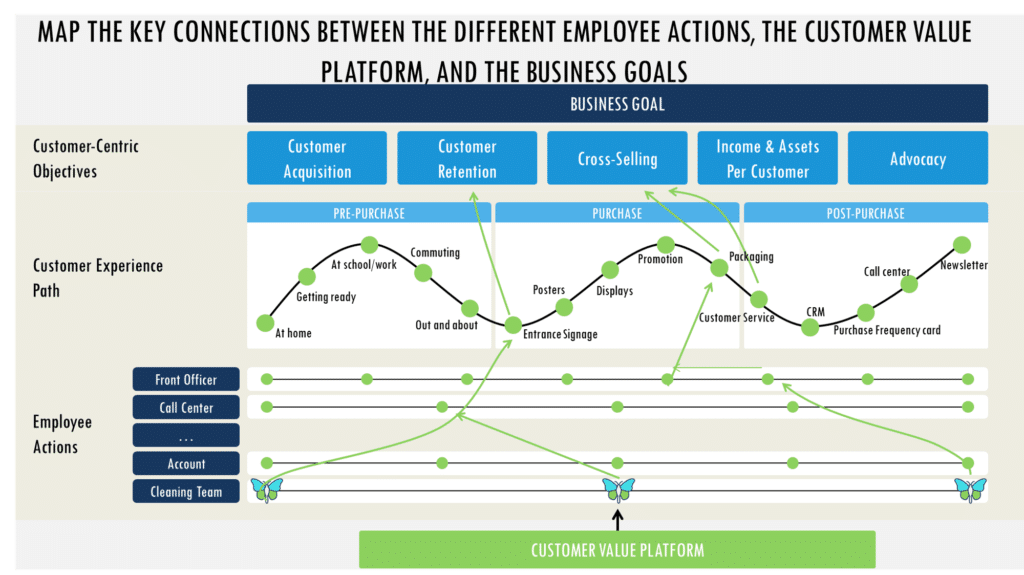David Packard, one of the founders of Hewlett Packard, once said that “marketing is too important to be left to the marketing department.” He was right – it is. If you believe that marketing is basically focused on promotion and communication you may not agree with his perspective. But if you view marketing as how you go to market, you are probably much more focused on how to create, deliver, and communicate your customer value. That’s marketing.

Now that we agree on what marketing is, it becomes pretty apparent that creating, delivering, and communicating your unique customer value is in some way part of what everyone in your organization is doing – or should be doing. This doesn’t mean the financing guys need to approve the ad copy. They should be aware that what they are doing has an impact on the customer experience. Or at least an impact on some other person or function in the organization that more directly creates, delivers, or communicates customer value.
Like the famous ‘butterfly effect’ where a butterfly flapping its wings near the Amazon River indirectly connects to different events and activities that ultimately have an impact on weather 10,000 km away. Organizational involvement in customer value is much less complicated, but taking advantage of the concepts starts with recognizing that everything and everyone does matter in some way. Identifying how it matters and what you can do to make it matter more (i.e., build greater customer value) is what the butterfly effect applied to your business is all about.
Key truths about organizational involvement
Truth #1
Employees are not typically aware of how they can have a major impact on the customer experience and the company’s overall top business goals. Most of the time they are not even aware of the customer value your company provides. Ask around. Ask different people in the organization (high and low) and if you get a wide range of answers, then clearly defining what you are all about is probably a good place to start.
Truth #2
Employees typically disregard the impact of their individual daily actions on the overall organization and on customer experience. Consequently, you need to raise their awareness and knowledge of how their daily actions impact other functions in the organization and/or the customer experience, either directly or indirectly. Show them how they are already on the way to making an impact. It’s much easier for employees to further drive customer value if they feel that what they already do matters and has an impact.
Defining Customer Value
Simple and easy to describe
The problem with clearly defining customer value so that everyone in the company understands it is that you might be overthinking it. It should be simple to say and easy to describe. If it isn’t, then not having everyone in the organization aligned is not your real problem. You may be focusing on what you do rather than on what you do for your customers.
As Steve Balmer, former CEO of Microsoft said, “Technology is only important in what it does for people. Beyond that, it is just science.” It is easy to get caught up in what you do, that’s what makes you good at it. But don’t get so lost that you forget the customer experience. Take a step back. Look from the customer’s perspective. For example, take a look at your TV remote and ask yourself if the people who designed it were more concerned with all the things they could or the experience you would have when using the remote. Unless you’re an engineer, you probably don’t know how to use 75% of the functions on your TV remote and all those extra functions get in the way of what you regularly want to do – relax and watch some TV.
There are a number of tools that can help you define customer value in terms of the emotional and functional benefits of your product. It is not so important what tool you use to figure it out. What is important is that you get there in the end and recognize clearly and simply what value you need to provide just to be in the game (sometimes called a frame of reference, or the competitive set). From there, you build on what makes you different, better, and more special than the available alternatives to your customer.
Get everyone on board
Once you have clearly defined your customer value, you then need to make sure that everyone understands the meaning of that customer value and how it applies to them. This ensures that instead of just doing things, they are doing the right things – thus adding customer value. It sounds pretty basic, and it is. The problem is that most people in most companies have no idea; their focus is on the tasks and not the customer.
Get people across the organization to start thinking about how they can deliver better value to the customer. Assign objectives rather than tasks. What do you expect or want the customer to do that they can impact? You need customer-centric objectives if you expect to get people to think more about what they do to benefit your customers. Ask people in different departments to think about their objectives in terms of customer impact and come back to you with ideas about how they can build or deliver greater customer value in order to accomplish each particular objective (i.e., processes, tactics, strategies, etc.). To capture the enthusiastic participation of everyone in the organization in delivering customer value, you must recognize and appreciate their individual contributions.
The customer path
Providing better customer value doesn’t just happen at the moment of truth – when the customer actually buys and uses your product. It starts earlier so they have the opportunity to consider your product or service as a viable alternative to whatever needs they may have. And it often continues through multiple purchases and multiple uses so that your customer not only becomes loyal to your product, they also feel so strongly about the value you provide that they tell other people – they advocate. This example is of a customer path for a bank.

Exponential customer value and putting the butterfly effect to good use
Exponential customer value goes even further than mere focus. Leaders of truly customer-centric companies have discovered the power of spreading and inspiring the creation, delivery, and communication of customer value throughout the organization. They don’t just personally light a fire in an organization; they create an atmosphere and an environment of thousands of fires lit – every day.
Using the same customer path example as we used for a bank, adapt it to your product or service with the appropriate customer path and the appropriate customer-centric objectives. Then add the different functional areas of your business. The first two functional areas shown are pretty easy to connect to the customer experience. They are fairly easy to identify and you can simply ensure they are driven by the customer value platform to accomplish various customer-centric objectives along the customer experience path. The last two examples are less involved in the customer experience but they affect it, too. So they also need to know and understand the customer value platform. Your job is to help them understand their role and how they can impact the customer experience, directly or indirectly.

Learn from the best in their class
Any McDonald’s operations manager will tell you that the cleaning team and their daily work keeping the bathrooms clean and fresh has a direct impact on customer retention and repeat purchases. Senior McDonald’s managers’ in-store visits check the bathrooms almost immediately as an indicator of how effective a specific store manager is. Why? Because it matters!
IKEA has a well-known return policy that makes it easy for the customer to return a damaged product. A good IKEA manager will not just ask his forklift drivers, who scurry around all night re-stocking the shelves, to report if they accidentally bump into a box. They will involve them in the customer experience by telling them a story about a father who bought an IKEA princess bed for his daughter and how excited he was to assemble it for her to sleep in the night after they returned from the store. But then they discovered a damaged piece. They lost the moment. The daughter wasn’t going to sleep in the bed that night and the father felt terrible for her disappointment. It didn’t matter that IKEA would replace the broken piece the next day, they lost the moment. Forklift drivers are dads, too. They get it.
The IKEA manager who involves the forklift drivers in the customer experience and the McDonald’s manager who involves the cleaning crew by showing them how important clean and tidy bathrooms are to the reliability and quality value pillar of McDonald’s do much better in achieving their sales goals than managers who don’t. So the question isn’t whether you are going to start involving more and more people across your organization in the customer experience and making everyone a marketer. The real question is: how soon can you get started?



